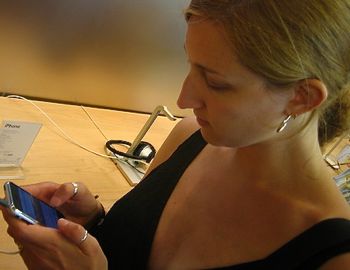It’s Science! iPhone Not Great For Typing
Nov 14th, 2007 | By James Lewin | Category: iPods & Portable Media Players 
User Centric, a Chicago-based usability consultancy, has published a new study examining the usability of typing on Apple’s iPhone.
The study found that – hold onto something – typing on the iPhone isn’t as accurate as typing on QWERTY phones.
You’re More Than Twice As Likely To Type Something Stupid With An iPhone
When compared to hard-key QWERTY phone owners using their personal phones, iPhone owners’ rate of text entry on the iPhone was equally rapid. However, iPhone owners made more errors during text entry and also left significantly more errors in the completed messages:
- While iPhone owners made an average of 5.6 errors/message on their own phone, hard-key QWERTY owners made an average of 2.1 errors/message on their own phone.
- iPhone owners also left an average of 2.6 errors/completed message created on the iPhone, compared to an average of 0.8 errors/completed message left by hard-key QWERTY phone owners on their own phone.
“Despite the correction features available on the iPhone, this data suggests that people who have owned it for a month are still making about the same number of errors as the day they got it,” says Gavin Lew, Managing Director.
We’ve found that Apple’s error-correction seems to introduce almost as many errors as it fixes. Sometimes, iPhones even seem insistent on correcting things that you don’t want corrected.
Furthermore, when iPhone owners were asked to perform a text correction task during their sessions, 21% of iPhone owners were not aware of the magnifying glass correction feature although they had owned their iPhone for one month. Participants who did know about the feature clearly loved it, and participants who were new to it indicated that it would be useful in the future.
iPhone May Not be Suitable for Heavy Text Use
Based on their research, User Centric says that “the iPhone may fall short for consumers who use on their mobile device heavily for email and text messaging.”
The iPhone was clearly associated with higher text entry error rates than a hard-key QWERTY phone. The finding that iPhone owners made more texting errors on iPhones than their hard-key QWERTY counterparts (on their own QWERTY phones) suggests that the iPhone may have a higher fundamental error rate. Specifically, the high rate of false alarms for iPhone keys adjacent to high frequency letters is troubling. The iPhone’s predictive and corrective text features do alleviate some of the errors users make while texting, but it does not catch them all.
“The iPhone is a great switch from a numeric phone. But if you’re switching from a hard-key QWERTY phone, try the iPhone in the store first,” recommended Lew.
Usability Isn’t Everthing
While User Centric’s look at typing on the iPhone is interesting – usability isn’t everything. What’s made the iPhone a success is its balance of usabilty, functionality and sex. People love sexy gadgets, and the iPhone is the sexiest in years.
It would be even sexier, though, if Apple would work with third party manufacturers to support a keyboard for the iPhone. A keyboard would allow the iPhone to be uses as a desktop replacement in many situations. At the recent Blogworld expo, very few people were actually blogging – probably in large part because there weren’t a lot of places you could plug in a laptop. An iPhone with an accessory keyboard would let people blog away for hours and hours, with much more freedom, than you can easily do with laptops.
Image: adactio